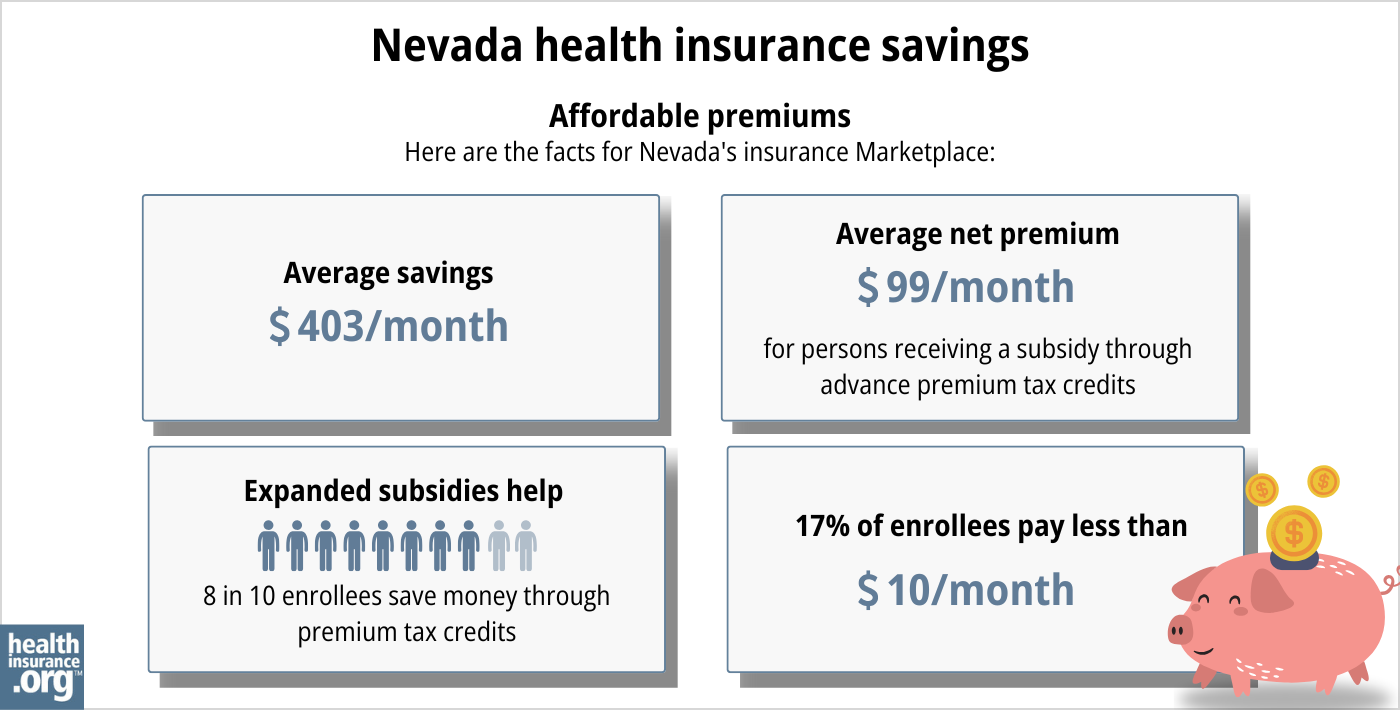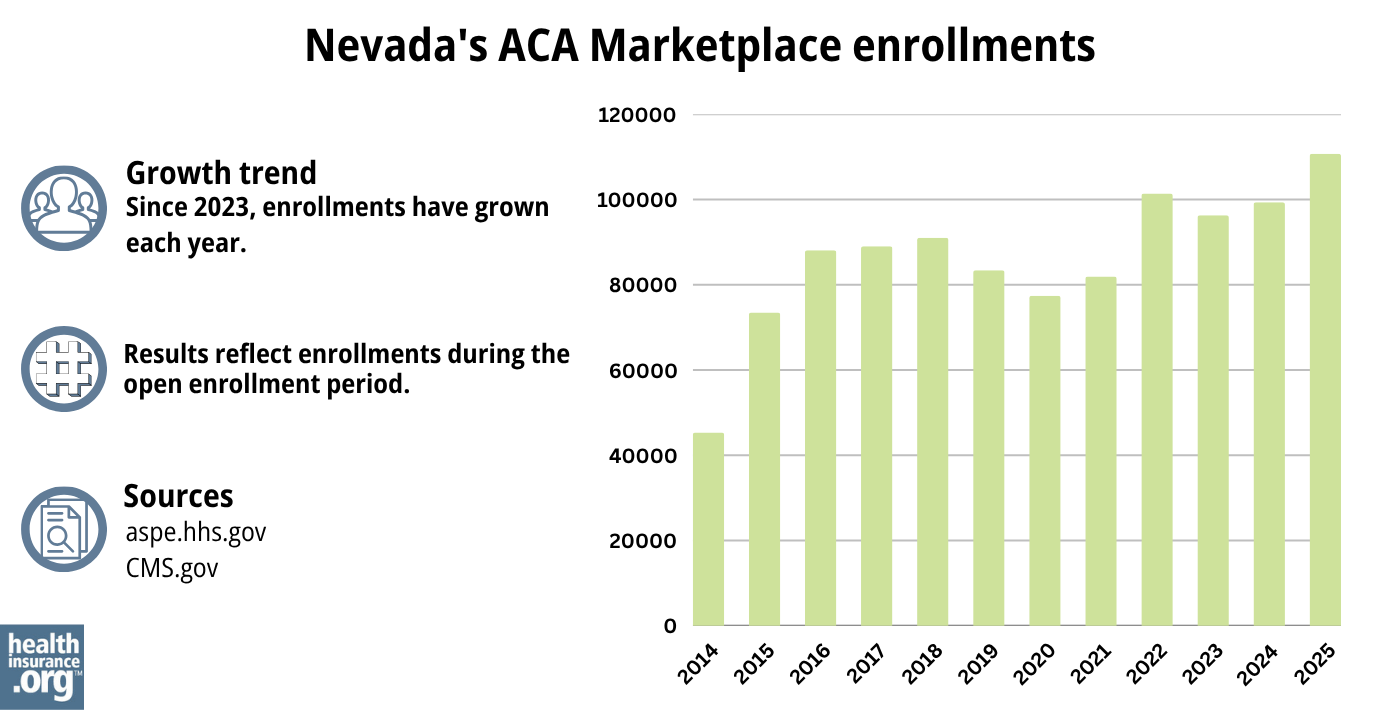Home > Health insurance Marketplace > Nevada
Nevada Marketplace health insurance in 2025

Compare ACA plans and check subsidy savings from a third-party insurance agency.

Nevada health insurance Marketplace guide
We’ve created this Nevada health insurance guide and the FAQs below to help you understand the health coverage options and possible financial assistance available to you and your family.
Nevada created its own state-based exchange, called Nevada Health Link, which is overseen by the Silver State Health Insurance Exchange.3 (Nevada had a state-based exchange platform in 2014, switched to the federally-facilitated HealthCare.gov platform for 2015 through 2019, then switched back to a state-based platform in 2020.)
Eight private insurance companies offer Marketplace plans through Nevada Health Link for 2024,4 including two that were new for 2024. Plans from all eight insurers have been approved for 20255 (see details below). Income-based subsidies are available through Nevada Health Link, making coverage much more affordable than it would otherwise be.
Nevada’s Market Stabilization Program (previously known as the Public Option) will be in effect as of 2026, with “Battle Born State Plans” available for purchase starting in November 2025. This program is described in more detail below, in the section about affordable health insurance in Nevada.
A Nevada Health Link plan can be a great coverage option if you aren’t eligible for Medicare or Medicaid, and also don’t have an offer of affordable health insurance from your employer.
Frequently asked questions about health insurance in Nevada
Who can buy Marketplace health insurance?
In order to sign up for private health coverage through Nevada Health Link, you must:6
- Live in Nevada
- Be lawfully present in the United States
- Not be incarcerated
- Not be enrolled in Medicare7
By those rules, most Nevada residents qualify to use the exchange. But a bigger question for most people is financial assistance, and there are a few additional parameters to be eligible for subsidies in Nevada’s exchange.
To qualify for income-based Advance Premium Tax Credits (APTC) or cost-sharing reductions (CSR), you must:
- Not have access to affordable health coverage through an employer. If you have access to an employer’s plan but it seems too expensive, you can use our Employer Health Plan Affordability Calculator to see if you might qualify for premium subsidies via Nevada Health Link.
- Not be eligible for Medicaid or Check Up (CHIP).
- Not be eligible for premium-free Medicare Part A.8
- If married, file a joint tax return.9
- Not be able to be claimed by someone else as a tax dependent.9
Beyond those basic parameters, qualifying for Nevada Health Link subsidies depends on your household income, which is an ACA-specific calculation of MAGI.
When can I enroll in an ACA-compliant plan in Nevada?
You can sign up for an ACA-compliant individual or family health plan in Nevada between November 1 and January 15, which is the annual open enrollment period.
For coverage to take effect on January 1, you need to complete your application by December 31.10 (This is later than the deadline in most states.) If you enroll between January 1 and January 15, your coverage will take effect on February 1.11
Outside of the annual open enrollment window, you may be eligible to enroll if you experience a qualifying life event, such as giving birth or losing other health coverage. Note that some people can enroll year-round even without a specific qualifying life event.
Enrollment in Nevada Medicaid/Check Up (CHIP) is available year-round.
A note about off-exchange enrollment: From 2014 through 2019, Nevada law required plans sold outside the exchange to be available for purchase year-round, with a waiting period of up to 90 days before the coverage would take effect. But Section 56 of Nevada SB482, enacted in 2019,12 eliminated the requirement that health plans be available year-round outside the exchange. The law took effect October 1, 2019, bringing Nevada’s rules into line with the rest of the country: Both on-exchange and off-exchange, individual major medical plans can only be purchased outside of open enrollment if the applicant has a special enrollment period (most special enrollment periods are triggered by a qualifying life event).
How do I enroll in a Nevada Marketplace plan?
To enroll in an ACA Marketplace/exchange plan in Nevada, you can:
- Visit Nevada Health Link, which is Nevada’s health insurance exchange (another word for Marketplace). Nevada Health Link is an online platform where you can compare plans, determine whether you’re eligible for financial assistance, and enroll in the plan that best meets your needs.
- Purchase Nevada Health Link coverage with the help of an insurance broker or navigator.13
You can reach the Nevada Health Link call center by calling 1-800-547-2927, Monday to Friday, 9 am to 5 pm.
How can I find affordable health insurance in Nevada?
The Affordable Care Act (ACA) provides income-based subsidies that can help lower your premium payments each month. These subsidies are available to Nevada residents who meet the eligibility requirements and enroll in coverage through Nevada Health Link.
Eighty-six percent of Nevada Health Link enrollees were receiving premium subsidies as of early 2024, and these subsidies reduced their average health insurance premiums by $437/month. After subtracting subsidies, the average enrollee’s premium was about $151/month.14

Source: CMS.gov15
If your household income is no more than 250% of the federal poverty level, you may also be eligible for cost-sharing reductions (CSR), which will reduce your deductible and other out-of-pocket expenses. These benefits are built into Silver-level plans if the applicant is eligible for them. As of 2024, nearly half of Nevada Health Link’s enrollees were receiving CSR benefits. 14
You can use both APTC and CSR benefits if you’re eligible for both and you select a Silver-level plan through Nevada Health Link (APTC can be used with plans at any metal level, but CSR benefits are only available on Silver plans).
Market Stabilization Program (Public Option) with reinsurance coming in 2026
Nevada S.B.420, signed into law in June 2021,16 calls for the state to create a public option health plan that will be available in the individual market as of 2026. The idea is to create premium reduction targets, similar to the approach that Colorado is using.
Gov. Lombardo, who took office in 2023, was critical of the public option approach, and worked to transform it into a “market stabilization program” instead. Under Lombardo’s plan there will still be a public option component, with a quality incentive payment program for insurers to prevent reimbursement cuts for medical providers due to the premium reduction targets. Lombardo’s plan also calls for a reinsurance program that would use federal funding to reduce premiums in the individual market.17 (Reinsurance programs are already in use in 17 states.)
Nevada is working with CMS to secure a 1332 waiver for the reinsurance program and the Market Stabilization Program plans (Battle Born State Plans) both of which are still expected to debut for the 2026 plan year.18 CMS was considering the 1332 waiver proposal but Nevada asked CMS to pause that process in March 2024, while the state amends its application due to new actuarial assumptions and evolving design of the program. Review of the 1332 waiver proposal will resume after that information is submitted.19
Depending on your income and circumstances, you may be able to enroll in free or low-cost health coverage through Medicaid or Check Up (Nevada’s CHIP). You can learn more about whether you might meet the criteria for Medicaid in Nevada.
How many insurers offer Marketplace coverage in Nevada?
Are Marketplace health insurance premiums increasing in Nevada?
For 2025 coverage, the following average rate changes have been approved for Nevada’s Marketplace insurers,22 amounting to a weighted average rate increase of 7.3%23 before any subsidies are applied.
Nevada’s ACA Marketplace Plan 2025 APPROVED Rate Increases by Insurance Company |
|
|---|---|
| Issuer | Percent Increase |
| Anthem Blue Cross Blue Shield (HMO Nevada) | 9.91% |
| Health Plan of Nevada | 4.5% |
| SelectHealth | 8.7% |
| Silver Summit | 0.9% |
| Aetna Health | 24.1% |
| Hometown Health Plan | 10.97% |
| Imperial Insurance Companies | 8.93% |
| Molina Healthcare of Nevada | -7.8% |
Source: Nevada Division of Insurance22
Three additional carriers offer individual market coverage only outside the exchange in Nevada. We have not included their premium changes in the chart above, since they don’t offer coverage in the Marketplace. But you can see details here.
It’s important to remember that these proposed average rate increases are for full-price plans, and most enrollees do not pay full price: As of 2024, 86% of Nevada Health Link enrollees were receiving premium subsidies that reduced their monthly payments.24
The subsidy amount is different for each enrollee and changes each year depending on the cost of the second-lowest-cost Silver plan relative to the enrollee’s household income. As a result of the American Rescue Plan and the Inflation Reduction Act, subsidies are larger and more widely available than they were in the past, and that will continue to be true at least through 2025.25
Changes in full-price premiums depend on the insurer and the plan (premium changes vary across the plans that each insurer offers), as well as the enrollee’s age and zip code.
For people who receive premium tax credits – which includes the vast majority of Nevada Health Link enrollees – the net premium change also depends on how much the subsidy amount changes from one year to the next.
Here’s an overview of how average full-price premiums have changed over the years in Nevada’s individual/family market:
- 2015: Average increase of 4%.26
- 2016: Average increase of 9.6%.27
- 2017: Average increase of 10.6%.28
- 2018: Average increase of 38.2%.29
- 2019: Average increase of 0.4%.30
- 2020: Average increase of 1.7%.31
- 2021: Average increase of 4.9%.32
- 2022: Average increase of 4.1%.33
- 2023: Average increase of 9.2%.34
- 2024: Average increase increase of 2.8% (3.6% including off-exchange plans).4
How many people are insured through Nevada’s Marketplace?
According to Centers for Medicare & Medicaid Services (CMS) data, 99,312 people selected private plans through Nevada Health Link during the open enrollment period for 2024 coverage.35
Effectuated enrollment is always a little lower than the number of people who select plans during open enrollment. CMS reported that effectuated enrollment through Nevada Health Link stood at 96,947 people as of early 2024.24

Source: 2014,36 2015,37 2016,38 2017,39 2018,40 2019,41 2020,42 2021,43 2022,44 2023,45 2024,46 202547
What health insurance resources are available to Nevada residents?
Nevada Health Link: This is Nevada’s Marketplace, used to enroll in individual/family health plans and receive income-based subsidies. You can contact Nevada Health Link at 800-547-2927.
Nevada Department of Health and Human Services: The Nevada Department of Health and Human Services (DHHS) administers Medicaid and Check Up (CHIP), as well as other social services programs. You can reach Nevada DHHS by phone at (775) 684-4000 or by email at [email protected]
Nevada Division of Insurance: Regulates Nevada’s insurance industry, and assists consumers and businesses with insurance-related questions and concerns.
Nevada State Health Insurance Assistance Program: A local service for Medicare beneficiaries and their caregivers. Provides information and assistance with questions related to Medicare eligibility, enrollment, and claims.
Louise Norris is an individual health insurance broker who has been writing about health insurance and health reform since 2006. She has written dozens of opinions and educational pieces about the Affordable Care Act for healthinsurance.org.

Looking for more information about other options in your state?
Need help navigating health insurance options in Nevada?
Explore more resources for options in Nevada including short-term health insurance, dental insurance, Medicaid and Medicare.
Speak to a sales agent at a licensed insurance agency.
Footnotes
- ”2025 OEP State-Level Public Use File (ZIP)” Centers for Medicare & Medicaid Services, Accessed May 13, 2025 ⤶ ⤶
- ”Nevadans Get a Preview of 2025 Proposed Health Insurance Rate Changes for Upcoming Open Enrollment” and “Health Insurance Rate Change Search Results” Nevada Division of Insurance. Accessed Oct. 4, 2024 ⤶
- “Silver State Health Insurance Exchange” nevadahealthlink.com, Accessed August 2023 ⤶
- OCTOBER 2, 2023 – Discover Your Best Health Plan: 2024 Rates and Options Now Available. Nevada Division of Insurance. October 2023. ⤶ ⤶
- ”Nevadans Get a Preview of 2025 Proposed Health Insurance Rate Changes for Upcoming Open Enrollment” and “Health Insurance Rate Change Search Results” Nevada Division of Insurance. Accessed Oct. 4, 2024 ⤶ ⤶
- ”Who can use Nevada Health Link?” Nevada Health Link, Accessed August 2023 ⤶
- Medicare and the Marketplace, Master FAQ. Centers for Medicare and Medicaid Services. Accessed November 2023. ⤶
- Medicare and the Marketplace, Master FAQ. Centers for Medicare and Medicaid Services. Accessed November 2023. ⤶
- Premium Tax Credit — The Basics. Internal Revenue Service. Accessed June 10, 2024. ⤶ ⤶
- Nevada deadline confirmed via email with Nevada Health Link’s communications department in November 2023 ⤶
- “How to Enroll” Nevada Health Link, Access August 2023 ⤶
- Nevada Senate Bill 482. BillTrack50. Enacted May 2019. ⤶
- “Entities Approved to Use Enhanced Direct Enrollment” CMS.gov, April 28, 2023 ⤶
- ”Effectuated Enrollment: Early 2024 Snapshot and Full Year 2023 Average” CMS.gov, July 2, 2024 ⤶ ⤶
- “2025 Marketplace Open Enrollment Period Public Use Files” CMS.gov, May 2025 ⤶
- Nevada Senate Bill 420. BillTrack50. Enacted June 2021. ⤶
- Governor Joe Lombardo Announces Plan to Transform the Nevada Public Option into Market Stabilization Program. Nevada Governor Joe Lombardo. October 2023. ⤶
- ”Executive Director’s Report” Silver State Health Insurance Exchange. June 18, 2024 ⤶
- ”Section 1332: State Innovation Waivers — Nevada” CMS.gov. Accessed July 27, 2024 ⤶
- Plan Year 2024 Open Enrollment Period Health Insurance Plans and Rates Are Available Now on NevadaHealthLink.com. Nevada Health Link. October 2023. ⤶
- Nevada: *Final* Avg. Unsubsidized 2024 #ACA Rate Changes: +3.8%; Molina & Imperial Joining Market. ACA Signups. October 2023. ⤶
- ”Health Insurance Rate Change Search Results” Nevada Division of Insurance. Accessed Oct. 4, 2024 ⤶ ⤶
- ”Nevada: *Final* avg. unsubsidized 2025 #ACA rate changes: +7.3% (updated)” ACA Signups. Oct. 4, 2024 ⤶
- ”Effectuated Enrollment: Early 2024 Snapshot and Full Year 2023 Average” CMS.gov, July 2, 2024 ⤶ ⤶
- “Health Insurance Marketplaces 2023 Open Enrollment Report”CMS.gov, Accessed August 2023 ⤶
- Analysis Finds No Nationwide Increase in Health Insurance Marketplace Premiums. The Commonwealth Fund. December 2014. ⤶
- FINAL PROJECTION: 2016 Weighted Avg. Rate Increases: 12-13% Nationally* ACA Signups. October 2015. ⤶
- Avg. UNSUBSIDIZED Indy Mkt Rate Hikes: 25% (49 States + DC). ACA Signups. October 2016. ⤶
- 2018 Rate Hikes. ACA Signups. October 2017. ⤶
- 2019 Rate Hikes. ACA Signups. October 2018. ⤶
- 2020 Rate Changes. ACA Signups. October 2019. ⤶
- 2021 Rate Changes. ACA Signups. October 2020. ⤶
- 2022 Rate Changes. ACA Signups. October 2021. ⤶
- UPDATED: FINAL Unsubsidized 2023 Premiums: +6.2% Across All 50 States +DC. ACA Signups. Accessed November 2023. ⤶
- ”Health Insurance Marketplaces 2024 Open Enrollment Period Report” CMS.gov. March 22, 2024 ⤶
- “ASPE Issue Brief (2014)” ASPE, 2015 ⤶
- “Health Insurance Marketplaces 2015 Open Enrollment Period: March Enrollment Report”, HHS.gov, 2015 ⤶
- “HEALTH INSURANCE MARKETPLACES 2016 OPEN ENROLLMENT PERIOD: FINAL ENROLLMENT REPORT” HHS.gov, 2016 ⤶
- “2017 Marketplace Open Enrollment Period Public Use Files” CMS.gov, 2017 ⤶
- “2018 Marketplace Open Enrollment Period Public Use Files” CMS.gov, 2018 ⤶
- “2019 Marketplace Open Enrollment Period Public Use Files” CMS.gov, 2019 ⤶
- “2020 Marketplace Open Enrollment Period Public Use Files” CMS.gov, 2020 ⤶
- “2021 Marketplace Open Enrollment Period Public Use Files” CMS.gov, 2021 ⤶
- “2022 Marketplace Open Enrollment Period Public Use Files” CMS.gov, 2022 ⤶
- “Health Insurance Marketplaces 2023 Open Enrollment Report” CMS.gov, 2023 ⤶
- ”HEALTH INSURANCE MARKETPLACES 2024 OPEN ENROLLMENT REPORT” CMS.gov, 2024 ⤶
- “2025 Marketplace Open Enrollment Period Public Use Files” CMS.gov, May 2025 ⤶

